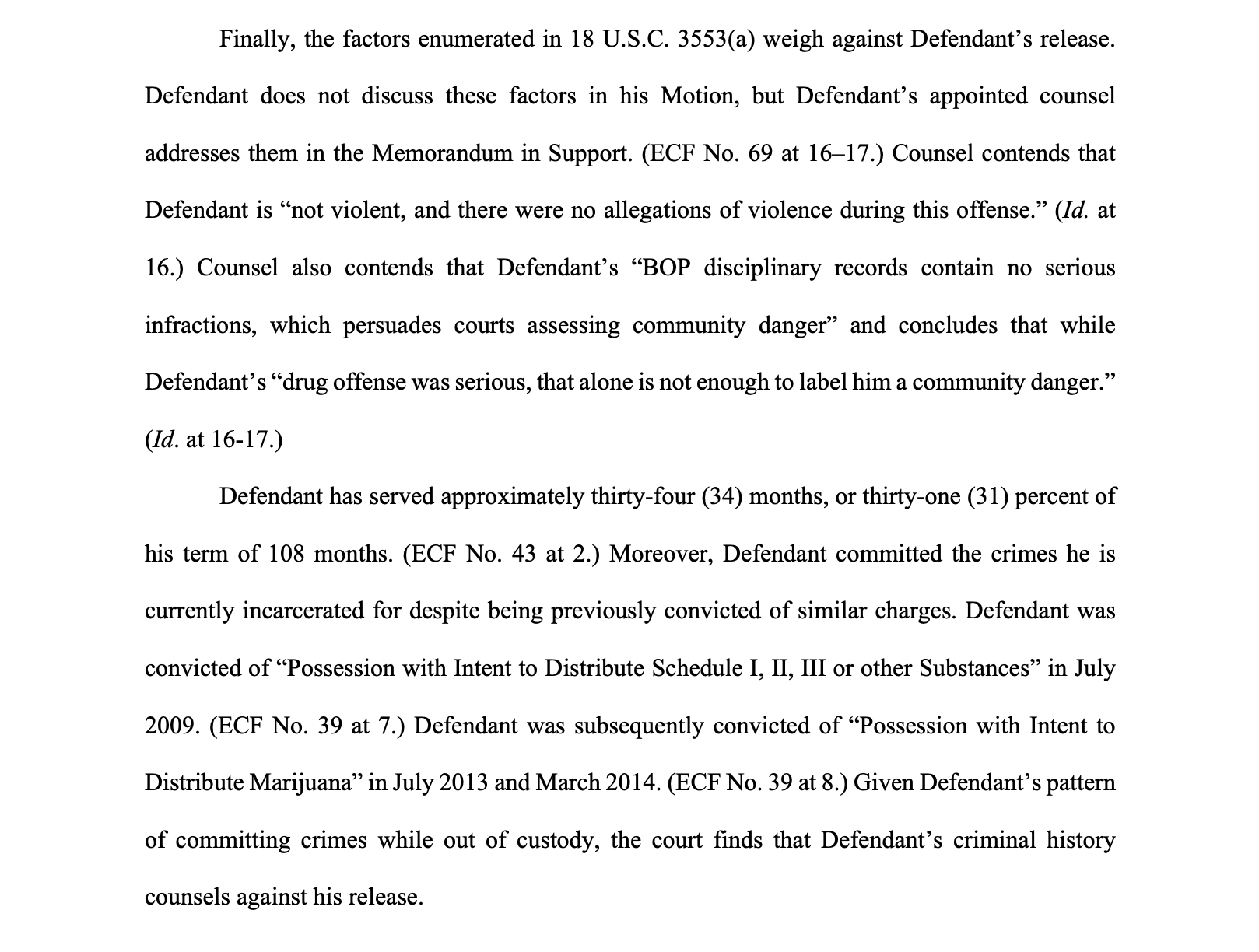One year in, one of President Joe Biden’s few meaningful accomplishments is his record of appointing civil rights and criminal defense attorneys onto lower federal courts. And with a Supreme Court vacancy opening up with the retirement of Justice Stephen Breyer, Biden has an opportunity to place the first justice with criminal defense experience onto the Supreme Court since Justice Thurgood Marshall. While many of the extremely qualified Black women in initial conversations are former public defenders, one who is not — Judge J. Michelle Childs, a South Carolina federal judge — has gained steam as a nominee, if not notoriety, in recent weeks. Progressives have already critiqued Judge Childs’ professional background as a management-side labor attorney, and there have been generalized complaints about her record on criminal law issues.
That said, a representative picture of Judge Childs’ judicial philosophy is difficult to assemble, as she is a trial court judge — and trial court judges don’t have the same paper trail of published, easily accessible decisions that appellate judges do. Despite this, it is possible to get a sense of her approach to criminal justice issues by looking at her rulings in cases that require her to grapple with incarceration and its consequences. After all, sending people to prison, or deciding whether they should stay there, is one of the most significant — and often the most wrenching — tasks trial judges confront. To better understand how Judge Childs has approached such decisions, I attempted to collect a complete set of her rulings with respect to applications for compassionate release. The rulings show how she responded to people in prison asking her to release them due to health or other exigent circumstances.
It is possible to get a sense of Judge Childs’ approach to criminal justice issues by looking at her rulings in cases that require her to grapple with incarceration and its consequences.
Compassionate release is a good window into how a judge views the criminal system. The current framework of federal compassionate release has only been around for a couple of years, so most cases are about the difficulty of incarceration in a pandemic. Many judges have stood by the system but will recognize that the pandemic has rendered some sentences unjust. And there is considerable variation in both directions.
Judges assess these cases in two steps: First, they ask if there is an extraordinary or compelling reason to reduce the person’s sentence. Second, they ask whether a reduction is consistent with the applicant’s history and personal characteristics (which the judge is required to consider under a federal statute called § 3553(a)).
Under this rubric, requests for compassionate release in recent years have required judges to confront the horrors of pandemic incarceration and the added harshness of a sentence that usually did not contemplate COVID-19. And judges have wide discretion to reduce a sentence; the reduced sentence is not subject to the harsh mandatory minimums enshrined in federal law. Despite this, judges often sidestep the question and conclude that things haven’t changed enough since sentencing, either in the urgency of an inmate’s situation or in the work they’ve done on themselves to grow despite that situation. Even if an applicant is almost done serving their sentence or has been actively participating in prison programs for several years, the odds are long — only 18 percent of compassionate release motions were granted in 2020 and early 2021.
These low rates of compassion seem hard to square with the basic nature of a pandemic that has torn through prisons at rates far more dangerous than in the broader population. Even then, it’s hard to overturn denials of compassionate release on appeal, given the broad discretion the law affords trial judges. Thus, a mixed record containing some grants and some denials of compassionate release might be tolerable if the judge is actually considering the arguments and agreeing to some reductions. It’s harder to stomach if the judge isn’t granting any motions.
Based on her 23 COVID-related compassionate release rulings available on Westlaw,* Judge Childs falls into that latter category.
A mixed record containing some grants and some denials of compassionate release might be tolerable if the judge is actually considering the arguments and agreeing to some reductions. It’s harder to stomach if the just isn’t granting any motions. Judge Childs falls into the latter category.
To find these 23 opinions, I ran a few searches in Westlaw for opinions by Judge Childs containing terms such as “compassionate release,” “sentence reduction,” or “3582”, the numbered section of the federal code that provides for compassionate release. This produced the 23 decisions I’ve analyzed, plus four others that mentioned compassionate release but were ultimately addressing other legal issues. Now, I should be clear up front that these 23 decisions may not capture every compassionate release decision Judge Childs has issued. West, the company that compiles district court decisions, gets to determine which compassionate release decisions go into the Westlaw database. But most compassionate release grants require a judge, at a minimum, to engage in detailed analysis, so the expectation is that compassionate release grants are usually on Westlaw. Even if this dataset is not fully complete, we can still learn something from the 23 decisions it contains.
As an initial matter, Judge Childs is getting a lot slower with compassionate release. Every available compassionate release decision from her since July 1, 2021 was on a motion that had been pending for over five months. That is a long time to wait if you are asking to be released from prison in the midst of an urgent and exploding pandemic, especially if you contend you have conditions that make you especially vulnerable. And Judge Childs has only ruled on one motion in front of her that was filed within the last year. (I’m almost certain she’s received far more than one compassionate release motion during that time.)
Now, things often move slowly in federal court. But the facts on the ground during a pandemic do not, and the justifications for compassionate release can become much stronger or weaker within a matter of weeks. Judge Childs, in two cases, seemed reluctant to recognize this. Her longest wait, in United States v. Walker, was nearly 10 months, where the motion requesting release was filed on October 1, 2020, and she issued her decision on July 14, 2021. Walker claimed that his cancer, his age, and a huge 2020 outbreak at his prison made him a good candidate for compassionate release. Ten months later, Judge Childs deemed the outbreak irrelevant, saying there were no longer any active cases. Her lack of a speedy decision, in other words, was a decision in its own right.
This is particularly egregious given that the federal Bureau of Prisons’s reporting of COVID is severely suspect. You are an “active” case for 10 days after testing positive, at which point, regardless of your continuing symptoms, you are “recovered.” Long COVID and lingering symptoms don’t exist, and confirmed outbreaks disappear within a matter of days. A judge who waits one week may find only a handful of positive cases, even if there were hundreds only days prior. It is therefore odd that a judge uses numbers from ten months after the original filing without at least acknowledging the time gap. There were two whole COVID waves in the intervening months. This is on top of Judge Childs’ habit of acknowledging that certain conditions increase COVID severity but never concluding that an individual inmate’s health risk is sufficient for any meager reduction in sentence, even when that inmate’s comorbidity is bladder cancer.
Judge Childs did the same in United States v. Black, where the applicant asked for release due to COVID health risks as well as to care for her ailing father. Judge Childs didn’t rule in Black’s case for nine months, at which point Black had less than a year left until her release. At that point, the judge invoked a discretionary provision of the Federal Sentencing Guidelines to conclude that Black’s argument that she needed to care for her sick family did not warrant compassionate release.
To be clear, the guidelines provision Judge Childs invoked, known as section 1B1.13, describes scenarios in which compassionate release is warranted, and it includes not only medical reasons but also reasons such as caring for an ailing child or spouse. While Black’s claim was slightly outside of 1B1.13’s scope (because she asked to care for her father, not a child or spouse), Judge Childs could have easily still granted release. Section 1B1.13 does not limit a judge’s authority to be compassionate in these circumstances. (I worked on a case in the Sixth Circuit decided in November 2020 that held that compassionate release claims do not have to fall within the scenarios listed in section 1B1.13 in order to qualify. The Fourth Circuit, which hears appeals from the District of South Carolina, where Judge Childs sits, adopted that rule as well just weeks later.) Still, after using the same time-skip logic to dismiss Black’s health concerns, Judge Childs dismissed her family care argument because it was technically outside the scope of Section 1B1.13.
In so doing, she demonstrated an unwillingness to grapple fully with the question of when a release from prison may be worthwhile, abdicating a judge’s responsibility to assess sentencing arguments holistically and meaningfully. Her approach shows a baseline disinterest in decarceration even for the most sympathetic of individuals.
My concerns so far focus on Step 1 of the compassionate release analysis, where judges assess the reasons that might support compassionate release. But if anything, I am more concerned about Judge Childs’ approach to assessing Step 2 of the analysis, where judges must consider a person’s history and characteristics.
In Black’s case, Judge Childs purports to analyze the § 3553(a) factors solely by reciting Black’s prior criminal convictions. There is no other analysis — just that her criminal history is too extensive to let her be released. And the list is not just convictions: Judge Childs mentions four old charges that Black was not convicted of, including a dismissed traffic infraction. I hesitate to see how any of that information is relevant to whether Black should be released a few months early due to a pandemic.
But the problem is not just that Judge Childs focused so intently on Black’s criminal history. It’s that she ignored so much else. The § 3553(a) factors should be familiar to every federal judge, as they are the core of every sentencing decision. The statute specifically outlines a dozen or so factors that a judge is supposed to consider, including one that highlights the need “to provide the defendant with needed . . . medical care . . . in the most effective manner.” Federal judges consider these factors before every single criminal sentencing. This means that the compassionate release stage is usually the second time a judge is assessing these factors for any given person.
Reassessing these factors in a compassionate release context thus necessarily require the judge to consider what has changed since the initial sentencing. A denial based on criminal history or other facts known to a judge at sentencing is self-fulfilling: the judge would just be reaffirming her initial decision. New facts can and must be considered, and the increasing age of old facts must be accounted for. But in our dataset, Judge Childs has never used any new facts in her § 3553(a) analyses. In United States v. Rollison, a case where she denies a cancer patient compassionate release despite there being one year left on the sentence, she notes that the person had received another federal sentence and then simply concludes: “Given Defendant’s pattern of committing crimes while out of custody, the court finds that Defendant’s criminal history counsels against his release.”

This is one of Judge Childs’ most used lines in compassionate release cases. She uses it again in United States v. Wilkins, where the “pattern of committing crimes while out of custody” is, as best as I can tell, three marijuana offenses. She uses a similar line in United States v. Gibson, even though the applicant there had served 90 percent of his sentence already (and was released shortly thereafter). She repeats the line in United States v. Whaley, despite not even explaining the specific convictions in the person’s record that lead her to this conclusion. She simply notes that the applicant was deemed to be a so-called career offender and that he “had a significant criminal history involving drug possession and drug trafficking offenses along with other minor criminal offenses.”
These are not cherry-picked examples. The cases discussed above capture every single case I could find where Judge Childs addresses the § 3553(a) factors in a compassionate release setting. As far as I can tell, she has never directly invoked a single fact about a person’s life story from after they were sentenced, and she has never mentioned a single good fact about anyone’s background. She has only ever brought up § 3553(a) to recite people’s prior charges. And she does it even when those charges are minor or even dismissed, copying and pasting the same language from one denial to the next.
When I set out to examine Judge Childs’ record in this setting, I was not expecting every case she considered to end in compassionate release. For many of them, her hands are tied because the applicant either hasn’t made the proper requests to the BOP prior to asking the judge, as the law requires, or hasn’t submitted any supporting information. Judge Childs’ denials in those cases are unsurprising to me.
Judge Childs’ record is a genuine outlier that is especially punitive and carceral when it comes to evaluating requests for compassionate release.
But I did not expect to find nothing but denials. And not just denials — Judge Childs has never, in any of these available decisions, ruled for anyone on either of the two steps. That’s unlike many other judges, who will often find extraordinary and compelling reasons but deny based on the § 3553 factors. In other words, Judge Childs’ record is a genuine outlier that is especially punitive and carceral when it comes to evaluating requests for compassionate release. And it’s not just that she is from South Carolina, either. The grant rate in Judge Childs’ district is 18 percent, which is right at the national average. She’s an outlier compared both to the country and her state.
Now, trial court judges can be put under a microscope far more easily than federal appeals court judges because they make more rulings, write more orders, and have less backup than those who rule on appeals. Our highest court should not just be former appellate judges — we need diverse prior experiences. But that diversity is needed so that the human cost of the law is understood, including when the law sends people to prison. Based on her record in compassionate release cases, I have serious doubts that Judge Childs would bring such understanding, or compassion, to the Supreme Court. Her complete refusal to recognize the violence of incarceration, even during a pandemic, should cause everyone to wonder how she might rule on the Supreme Court over the next 30 or more years.
Will she read federal criminal statutes narrowly, to avoid sentencing enhancements for defendants with substantial criminal histories? Stephen Breyer, for all his faults, has done so. Will she side with criminal defendants on Fourth Amendment challenges, cases that address a vital right to privacy, even when the evidence being challenged usually indicates a person’s factual guilt? Other leading candidates, many of whom are public defenders, are likely to be far more reliable on this question. Will she find that people who challenge their conditions of confinement have stated constitutional cases, given that she seems so willing to accept the state of incarceration over the course of the COVID-19 pandemic? Will she be a reliable vote to end the death penalty, given that she seems unwilling to prioritize the health and continued well-being of those in prison on shorter sentences? Will she even vote to stay executions in the meantime?
Put differently: Will she make it a priority to unwind some of the injustices that the Supreme Court has perpetuated over the last 200 years, especially on matters of criminal law and procedure?
Will Judge Childs make it a priority to unwind some of the injustices that the Supreme Court has perpetuated over the last 200 years, especially on matters of criminal law and procedure?
Representative James Clyburn, who has been championing Judge Childs’s nomination, responded to other criticism about Judge Childs’s criminal rulings with the following statement: “The insinuation that Jim Clyburn would support a nominee to the Supreme Court with the intent to undermine criminal justice reform is so preposterous that it discredits the integrity of this entire report.” But the question is not whether he intends to undermine criminal justice reform. The question is what Judge Childs would do if nominated and confirmed. Her copy-paste rulings denying compassionate release indicate that she may undermine — or worse, ignore — efforts to combat mass incarceration and the injustices of the American penal system if she is nominated and confirmed. As a career public defender, I believe that everyone, even Judge Childs, can change. But with what’s at stake with this Supreme Court nomination, I don’t think it’s worth the risk to find out if she will.
Image: Ed Hinchliffe/Unsplash

